Chrysler Air Raid Siren
| Chrysler Air Raid Siren | |
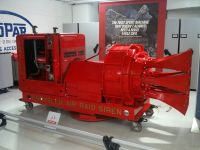 A Chrysler Air Raid Siren, which was located in the Walter P. Chrysler museum in Auburn Hills, MI before its closure in 2016. The siren is currently safely in storage. | |
| Company | Chrysler Corporation
Bell Laboratories |
|---|---|
| Produced | 1942-1957 |
| Type | Rotational Engine-Driven |
| Sound output | 138 dB @ 100 ft |
| Horsepower | 95-140 hp |
The Chrysler Air Raid Siren (originally known as the Chrysler Bell Victory Siren) is a gas engine-driven, rotational mechanical siren that was built by the Chrysler Corporation during World War 2 and the Cold War, and to this day holds the title as the loudest civil defense siren ever produced, producing a whopping 138 dB at 100 ft. Going through many design changes throughout its life, these "Big Red Whistles" made a name for themselves for many years.
Prototypes
Chrysler/Bullard Prototype
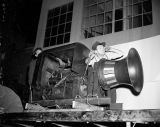
The earliest attempt at making a gasoline-driven siren powered by a Chrysler engine was made around 1941. Built by the Chrysler Corporation and the E.D. Bullard Company. Little is known about the specifications of this experimental siren, but it appears to have run on a Chrysler gasoline engine, with a large conical rotor and stator typical of Bullard's sirens. This large 12-port siren was produced for the War Production Board, who wanted a gasoline-driven siren that could function independent of external power. Several of these were built and tested by the War Production Board. This early attempt would ultimately fail to meet the Board's specifications, and multiple units suffered catastrophic rotor explosions leading to the sirens being scrapped and further research being done. It is speculated that the lack of a front bearing is what caused the rotor explosion, as units built in 1941 appear to only have two bearings behind the rotor, while a unit built in 1942 has a cap over the front of the stator which suggests the addition of a front bearing. At least one report was made that a loud scraping noise was heard before the rotor detonated, suggesting the rotor throwing itself out of alignment.
Big Bertha
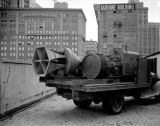
In early 1942, another attempt would be made, nicknamed "Big Bertha". Big Bertha was a very large siren that was mounted on the back of a flatbed truck, bearing some resemblance to the later Chrysler sirens. with its six horns placed in a hexagonal shape. It was developed by Bell Laboratories, under the leadership of Dr. Harvey Fletcher. The siren used a large American Locomotive Company (ALCo) compressor, which was driven by a 95 hp Ford engine. The siren's rotor was driven by a separate 20 hp Wisconsin engine, not dissimilar from the smaller engine used on BN52/BN54 Mobil Directos built a few years later. During testing, Big Bertha was found to reach 137 dB at 100 ft, only 1 decibel shy of the later Chrysler sirens and the loudest siren in the world at the time of its construction. While Big Bertha never made it beyond the single prototype unit, it would later lead to the Chrysler Air Raid Siren's creation later that year when the Office of Civil Defense had Bell Labs and the Chrysler Corporation work together to improve upon the siren.
Production Models
Chrysler-Bell Victory Siren
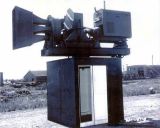

Later in 1942, Bell Laboratories and the Chrysler Corporation worked together to create two different siren models, being the Chrysler-Bell Victory Siren and Chrysler-Bell Gas Siren, the former of which is far more similar to the later Chrysler Air Raid Sirens. The two companies improved upon Big Bertha's design, replacing both the Ford and Wisconsin engines with a single Chrysler Straight-8 engine, which produced 140 hp. In addition, a new two-stage compressor created a direct flow of pressurized air that was sent directly into the siren's rotor, which boosted the siren's performance to 138 dB at 100 ft. The engine itself drove the siren's 6-port disc rotor through a driveshaft in the middle of the siren. The siren was placed on a rotational platform, which slowly rotated the entire siren unit at 1.5 rpm to project the sound across 360 degrees, and the six horns were made rectangular, in a 2x3 fashion.
Some early units used an extra projector horn over the six horns, while later units lacked the projector. The sirens were painted red, with golden text on the sides saying "CHRYSLER-BELL VICTORY SIREN". The siren's operator would have to sit on a seat placed on top of the siren to operate it, though early experimental units sat on top of an operator's booth. The siren's overall design was very similar to later production Chrysler Air Raid Sirens. In the late 1940's, the siren would be renamed to the Chrysler Air Raid Siren, though its design remained unchanged.
Several Chrysler Victory-Bell sirens were sent to China, where they were reverse-engineered to create various knockoff sirens. Some survive today, although one has had its engine replaced with a massive electric motor. It appears that Lion King's DEFENDER siren is one such copy of the Chrysler sirens, with the addition of wheels and a cab. Due to China's poor manufacturing quality, the engines on the DEFENDER often belch a large amount of smoke.
Chrysler-Bell Gas Siren
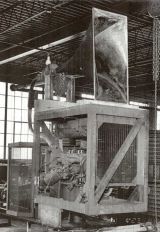
The Chrysler-Bell Gas Siren was a variant of the Victory-Bell Siren which was designed to operate on the exhaust gas as well as the engine, rather than being driven purely by the engine itself. The Gas Siren utilized a six-cylinder, 120 hp Chrysler engine to drive the chopper mechanism. The mechanism was built inside of a large rectangular truss-strengthened housing, and the siren's rotor and stator are above the siren. The exhaust gas from the engine supercharges the siren by forcing more air through the rotor at 300 cubic feet per minute, which makes it much louder. This allowed the siren to use a smaller engine while also no longer needing an air compressor or blower. The siren's output is projected through a massive exponential horn attached to the top of the siren. The entire siren sits on a stand, and may have had the ability to rotate like the standard Victory Bell Siren. The Chrysler-Bell Gas Siren is massive in size, being nearly 1.5 stories tall. These saw far less success than the Victory-Bell Siren likely due to its excessive size and cost, and none are known to exist today. It is unknown how well this siren performed compared to the Victory-Bell, and may never have reached the full production stage as no installations are known.
Chrysler Air Raid Siren
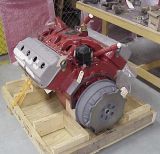
In 1952, the Chrysler Air Raid Siren would see its final redesign. The siren was shortened in length, with the two-stage compressor being replaced with a three-stage compressor, and the Chrysler Straight-8 engine being replaced by Chrysler's then-new 140 hp V-8 HEMI engine, which was more compact and efficient. In addition, the operator's seat was removed, with the controls now being located on the right side of the siren's engine cowling. Another improvement was the ability for the siren to be remotely controlled, with an external controller operating the siren's engine remotely without the need for an operator to be present on-site. This improved the siren's ability to operate quickly in the event of an emergency, giving a much earlier warning.
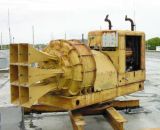
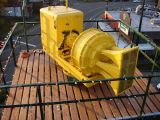
These were the most successful model of Chrysler siren, with most remaining existing units being these post-1952 models. These sirens produced 138 dB at 100 ft, with the siren blowing 2,610 cubic feet of air per minute, at 7 PSI. Reportedly, the siren was able to clear fog by turning it to rain, start fires with the sheer vibrations it created, and could be heard between 30 to 50 miles away on a clear day, its performance unmatched by any other siren ever made. To improve the siren's range, these sirens were often placed on top of tall rooftops or large steel towers, which made installing and removing them difficult and expensive. This model of Chrysler Air Raid Siren would be produced until 1957, when Chrysler exited the siren market as more practical high-performance electric sirens began to dominate the market, such as Federal Signal's Thunderbolt and H.O.R.'s Super Sirex.
The Chrysler Air Raid Siren continued to serve many communities for years during the Cold War, with many units remaining in service until the 1970s. Ultimately, the high cost of operation (including fuel and maintenance) as well as the sheer impracticality of using gasoline-driven sirens compared to electric sirens, led to all Chrysler sirens being retired from service by the 1980s as they were replaced with more economical sirens. Some communities found that these sirens were simply too heavy and mounted too high up to remove, leading to these sirens being left abandoned. Many removed units were gutted, as their V-8 Hemi engines proved popular as hot-rod engines.
Today, some Chryslers still sit on their mounts, rusting away as their salvage value fails to outweigh the costs of removing them. While most people do not recognize these sirens for what they were, some cities have chosen to keep them for historical reasons, with one even being turned into a Christmas tree every year at Phinney Park in Seattle, WA. Thankfully, several others have ended up preserved in private possession, with a handful in operating condition.